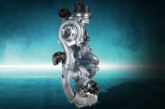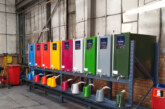VLS gives talk on the role of hydrogen

CVW spoke to Alan Outhwaite, head of the Verification of Lubricant Specifications (VLS) technical review panel, about the role of hydrogen in the net zero transition.
The race to net zero has been on for some time. Electric vehicles were seen as the answer, with OEMs developing hybrid and full electric vehicles to meet emissions targets. Hydrogen was also being explored as a potential solution – both in fuel cell operation and in combustion engines.
How do hydrogen vehicles work?
There are two main types of hydrogen propelled vehicles: a hydrogen fuel cell and a hydrogen-fuelled vehicle, and they both work in different ways.
A hydrogen-fuelled vehicle replaces conventional road fuel with compressed hydrogen gas or liquid gas. In these vehicles, the pressurised gas or liquid is injected directly into an engine’s pistons, and combustion takes place like a normal internal combustion engine vehicle. The primary emission from hydrogen combustion is water, a property that makes it an environmentally attractive fuel.
Most modern ICEs wouldn’t require much modification to run on hydrogen gas or liquid, but durability has not been proven in these systems, and appropriate lubricants are needed. These need to be formulated to minimise the potential for pre-ignition events, as well as manage increased levels of water in the crankcase to prevent corrosion, sludge formation and reduce wear. Service stations could be converted to dispense hydrogen gas or liquid with extensive changes required, and refuelling will take as much time as conventional fuels.
Specific engine management and filters can remove airborne contaminants such as NOx and SOx present due to the air intake for combustion to unmeasurable levels of emissions. The hydrogen gas is less dense than petrol or diesel, and the by-product of the combustion process is water vapour. Like conventional ICEs, hydrogen-fuelled vehicles still require specialist engine lubricants.
In a hydrogen fuel cell, instead of burning hydrogen gas, as is the case with hydrogen ICE-fuelled vehicles, the vehicle produces electricity through a chemical reaction between hydrogen from the storage tank and oxygen from the air in something called a fuel cell stack.
The stack powers the heart of the vehicle and generates electricity in the form of direct current (DC) from electrochemical reactions that take place in the fuel cell. Unlike a conventional battery, which stores electrical energy made elsewhere and releases it, hydrogen is an energy source in itself and releases some of its energy in an electrochemical reaction in the fuel cell. Electricity is then produced on demand.
The main advantage for vehicle owners is that, unlike pure electric vehicles, refuelling a tank for a hydrogen fuel cell from a pump takes less than five minutes. In contrast to ICEs, hydrogen fuel cell vehicles require no engine lubricants, though specialist fluids are required for transmission, braking and cooling systems.

Are hydrogen vehicles a viablesolution?
According to some OEMs, the answer is yes. In 2023, engineers at JCB Power Systems in the UK unveiled a hydrogen combustion engine, developed using and adapting established engine technology with readily available components. Their prototype backhoe loader, fitted with the new hydrogen motor, could do everything its diesel-powered equivalent could do.
The company described hydrogen as a “better way”, saying, “On a practical level, a hydrogen motor uses similar technology to existing propulsion systems. It’s also robust, cost-effective and it could be integrated into all forms of powertrain. Most importantly, a familiar technology and lack of complexity make hydrogen an ideal zero-carbon solution for our customers, with demand being met by our existing, high quality manufacturing supply chain.”
JCB installed one of its super-efficient hydrogen engines into a 7.5 tonne Mercedes-Benz Sprinter van to demonstrate the potential of hydrogen ICE vehicles. The white van retrofit was completed in just two weeks.
More recently, the testing phase of Project Cavendish, a £9.8m government funded programme facilitated by the Advanced Propulsion Centre UK (APC), began. The project is designed to drive hydrogen fuel use in existing heavy-duty truck engines with a clear path to enable hydrogen combustion using current platforms and infrastructure, accelerating the decarbonisation of the haulage sector.
Jonathan Hall, Mahle Powertrain’s head of research and advanced engineering, said: “Hydrogen combustion engines are well-suited to heavy-duty, long-distance applications that are hard to electrify. Its use allows industry to take advantage of years of development and investment as a means to accelerate the transition towards net zero.”
Toyota launched its third-generationfuel cell system (3rd Gen FC System) as part of its continued efforts toward “the realisation of a hydrogen society”. In 2024, Hyundai outlined its approach to hydrogen in their “Hydrogen Vision 2040: A roadmap toward a hydrogen society”, saying that hydrogen fuel cells are “pivotal in assessing the technological prowess of FCEVs”. The company hailed the progress of its XCIENT fuel cell electric heavy-duty trucks, which surpassed a cumulative driving distance of 10 million km in Swiss fleet usage, described as “a testament to the world-class hydrogen fuel cell technology’s long-term reliability.”
H2 generation is attracting a lot of investment in different methods. Green hydrogen is a ‘clean energy’ made using electricity from renewable energy sources, such as solar or wind power, to electrolyse water. Green hydrogen currently only makes up a small percentage of overall hydrogen production, but increased investment will help reduce costs over time, just as energy from wind power has reduced in price.
In the meantime, many fleet operators will hang onto their current ICE vehicles for as long as possible, as shown by the already ageing vehicle parc. According to the Automobile Manufacturers Association (ACEA) 2025 ‘Vehicles on European Roads’ report, the average age of vans is now 9.8 years, up from 7.8 in 2021. Trucks are now, on average, 11.6 years old, up from 7.3 years in 2021, and buses are now 16 years old, compared to 9.9 years in 2021.
For lubricant and specialist fluid manufacturers, motor factors and workshops, this means dealing with a more extensive and complex product range for the near future, catering to the needs of older vehicles as well as the latest models and a variety of powertrains.









